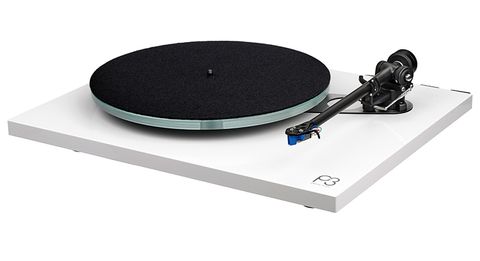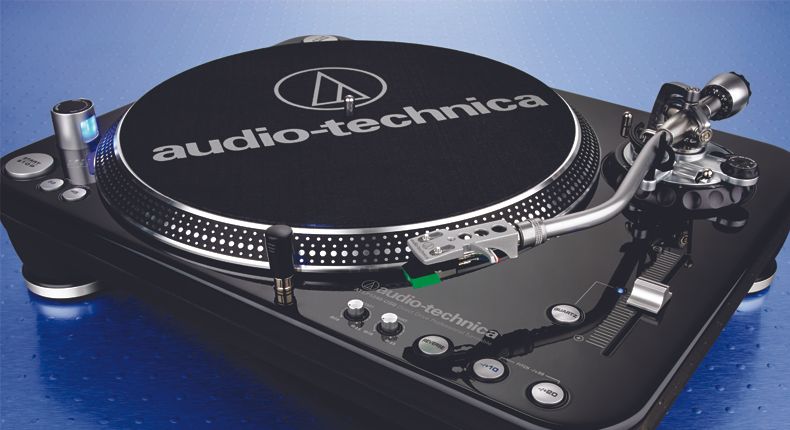If you wanted to get serious about sound on a budget in the 1980s, vinyl was your only option. For the most of the decade, Compact Disc was the domain of the wealthy; even the cheapest Philips machines cost over £300 towards the end of the decade. No, if you only had half that much money – or less – vinyl was the way to go.
Although a number of Japanese ‘budget audiophile’ turntables competed for hi-fi purchasers’ money in the early 1980s, from Sansui’s SR-222/II to Pioneer’s PL-512, there was only one legitimate option. Dual’s £120 CS 506 (CS meaning for’Complete System’) was a revelation when it was introduced at the Harrogate exhibition in 1980. It was a high-quality semi-automatic deck powered by a 16-pole synchronous motor that was belt-driven. The stroboscopic markings on the 304mm, 0.9kg platter worked in conjunction with an AC mains-powered strobe light and (6 percent) variable pitch control via the company’s “Vario Pulley” technology. Dual provided the tonearm.
The brand-new deck The CS 505, as a result, was a budget blockbuster in the truest meaning of the term. Most of the CS 506’s features were available for £75, without the strobe light and opulent wood plinth. Because neither of these improvements improved sound quality, the 505 differed little from its bigger brother in terms of performance, save for its higher price tag. When contrasted to this elegant bit of German engineering, every other entry-level turntable fell by the wayside.
It was fascinating to see a European brand do to the Japanese what Garrard and BSR had done a decade before. Every hi-fi publication scratched its head, unable to think of a reason not to acquire a CS 505! The Rega Planar 2, which cost nearly twice as much when the cost of a cartridge was taken into account, was the only visible update.
The CS 505 was not happy to rest on its laurels, and it was quickly enhanced. To build the CS 505/I in 1984, the basic belt-drive, independently sprung subchassis architecture was kept, but the finicky cartridge mounting technique was improved — and a better cartridge was installed. The CS 505-1 Improved received a reworked platter mat that provided stronger support, as well as a new plinth. The 1986 CS 505-2 had a better headshell and the option of a Deluxe edition, bringing back the real wood plinth from the now-defunct 506 model. The CS 505-3 received a 1.2kg platter for improved speed stability and a superior Dual ULM 65E bi-radial tipped moving magnet cartridge, while the ‘4 variant lost the classic pressed steel platter with stroboscopic markings and received minor detail finish adjustments.
The CS 505 was initially a huge hit, selling over 5000 units. This new £200 machine was introduced in 1987, and it was simply an improved ‘505 with a microprocessor-controlled, quartz-referenced motor and a 78RPM speed capability. It also had a superior Ortofon OM20 fitted cartridge and a better built arm with VTA adjustment. The enhancements resulted in superior measured performance, with a wow and flutter number of 0.025 percent and a S/N ratio of 80dB – figures similar to those found on 1970s superdecks like Technics’ SP10.
Rega’s dual turntables have never sounded better — the bass is light and painted, and the sound is little smooth and airbrushed. They make pleasant noises, with a smooth and sweet timbre and no evident vinyl nasties, but they’re uninteresting. The CS 5000 is similar, but far better: connect it into a current system, and it sounds incredibly polished and tuned, and it plays everything you want. It doesn’t, however, get as close to the music’s heart and soul as a Rega Planar 3.
The good news is that all Duals, particularly the CS 5000, are now fairly unfashionable, making them excellent beginning turntables. If you grew up with CDs, you’ll be surprised at how sweet and seductive vinyl can be for such a tiny investment. A good 505 may be had for £50, while an immaculate boxed CS 5000 can be had for £150. For £25, you can pair the former with an Audio Technica AT95E, but the latter is capable of tracking Goldring’s fantastic G1042. Avoid using a moving coil tonearm because the low mass tonearm is a poor mechanical match. A Dual is still the best deal in turntables now as it was back then.






